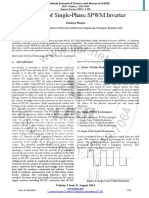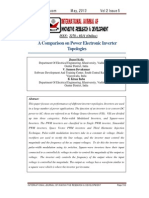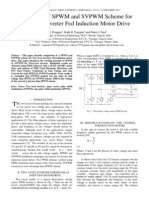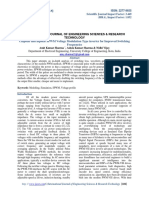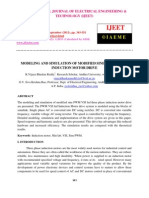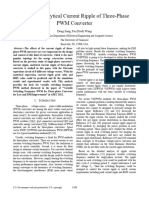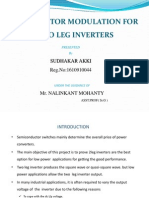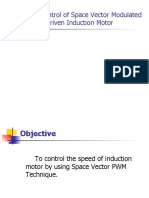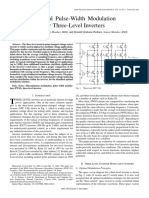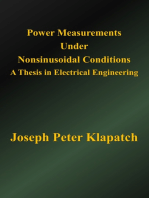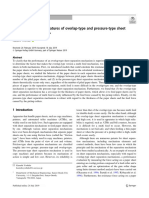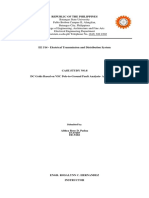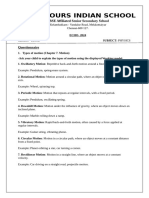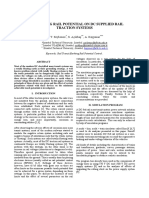Performance Analysis of Phase Shifted SPWM Technique For Three Phase Diode Clamped Three Level Inverter
Performance Analysis of Phase Shifted SPWM Technique For Three Phase Diode Clamped Three Level Inverter
Uploaded by
Elea JackCopyright:
Available Formats
Performance Analysis of Phase Shifted SPWM Technique For Three Phase Diode Clamped Three Level Inverter
Performance Analysis of Phase Shifted SPWM Technique For Three Phase Diode Clamped Three Level Inverter
Uploaded by
Elea JackOriginal Title
Copyright
Available Formats
Share this document
Did you find this document useful?
Is this content inappropriate?
Copyright:
Available Formats
Performance Analysis of Phase Shifted SPWM Technique For Three Phase Diode Clamped Three Level Inverter
Performance Analysis of Phase Shifted SPWM Technique For Three Phase Diode Clamped Three Level Inverter
Uploaded by
Elea JackCopyright:
Available Formats
© 2017 IJSRST | Volume 3 | Issue 2 | Print ISSN: 2395-6011 | Online ISSN: 2395-602X
National Conference on Advances in Engineering and Applied Science (NCAEAS)
16th February 2017
In association with
International Journal of Scientific Research in Science and Technology
Performance Analysis of phase shifted SPWM Technique for Three
Phase Diode Clamped Three Level Inverter
Anirudha Gedam, Saurabh Rahangdale, Shaharukh Pathan
Department of Electrical Engineering, Anjuman College of Engineering & Tech, R.T.M. Nagpur
University, Nagpur, Maharastra, India.
ABSTRACT
The Primary function of VSI is to convert fixed DC voltage into variable AC voltage at required voltage and
frequency. The diode-clamped multilevel inverter employs clamping diodes and cascaded dc capacitors to produce
ac voltage waveforms with multiple levels. The inverter can be generally configured as a three-, four-, or five-level
topology, but only the three-level inverter, often known as neutral-point clamped (NPC) inverter, has found wide
application in high-power medium-voltage (MV) drives. The dc input voltage of the inverter is normally split by two
cascaded dc capacitors, providing a floating neutral point. The control of the neutral-point voltage deviation is also
elaborated.The dc supplies are normally obtained from multipulse diode rectifiers. Phase shifted PWM Technique is
analyzed and its performance will be compared. Simulation results will be presented to analyze the performance of
the PWM techniques. The simulation results will be verified using experimental results
Keywords : SPWM, MV, DC, NPC, PWM, VSI, ASD, UPS, FACTS, SHE
I. INTRODUCTION II. METHODS AND MATERIAL
Inverter is device which converts electrical energy in A. Need of three Level Inverter
DC form into AC form. The main objective of static
power converters is to produce an AC output waveform The output voltage contains higher values of Total
from a dc power supply. These are the types of Harmonic Distortion(THD), hence fundamental
waveforms required in adjustable speed drives (ASDs), component gets reduced. In two level inverter there are
uninterruptible power supplies (UPS), static VAR more switching stresses on the devices. Such inverters
compensators, active filters, flexible ac transmission are not applicable for high voltage application. The
systems (FACTS) and voltage compensators. The higher voltage level are not produced in two level
primary function of a voltage source inverter (VSI) is to inverter. Since higher switching frequency is used,
convert a fixed dc voltage to three-phase ac voltage hence switching losses are high. Where high-quality
with variable magnitude and frequency. voltage waveforms are required, power converters,
specifically inverters are constructed from power
In voltage source inverter thyristor, IGBT, MOSFET, switches and the ac output waveforms are therefore
GTO can be used as switches. Generally thyristor are made up of discrete values. This leads to the generation
not used because they require forced commutation. of waveforms that feature fast transition rather than
Single-phase voltage source inverters (VSIs) and smooth ones. For instance, the ac output voltage
current source (CSIs) can be found as half-bridge and produced by the VSI of a standard ASD is a three-level.
full-bridge topologies. Although this waveform is not sinusoidal expected its
fundamental component behaves as such. This behavior
should be ensured by a modulating technique that
NCAEAS2353 | NCAEAS | ACET | January-February-2017 [(3)2: 336-340]
336
Volume 3 | Issue 2 | IJSRST/Conf/NCAEAS/ACET/2017/53
controls the amount of time and the sequence used to SWITCHING STATE OF THE THREE-LEVEL DIODE
switch the power valves on and off. The modulating CLAMPED INVERTER.
techniques most used are the carrier-based technique
(e.g., sinusoidal pulse width modulation, SPWM), the
space-vector (SV) technique, and the selective-
harmonic-elimination (SHE) technique, phase shifted
pulse width modulation. The discrete shape of the ac
output waveforms generated by these topologies
imposes basic restrictions on the applications of
inverters.
B. Three Phase Diode Clamped Three Level Inverter
In the recent past the multilevel power converters have
drawn a tremendous interest in the field of high voltage
and high power applications field in industries. The
multilevel inverter approach allows the use of high
power and high voltage electric motor drive systems.
Using the multilevel inverter concept, a divide and
conquer approach allows more flexibility and control
over the discrete components that makeup the system.
In the researches on multilevel inverters, their
corresponding PWM control strategies are the emerging Figure 2. Desired pole voltage for three level
research areas. In high power and high voltage
applications, the two level inverters, however, have 3.SINUSOIDAL PULSE WIDTH MODULATION
some limitations in operating at high frequency mainly
due to switching losses, dv/dt and di/dt stresses in Sinusoidal pulse width modulation is a method of pulse
power semiconductor devices and constraint of the width modulation used in inverters. An inverter
semiconductor power device ratings. For high voltage produces an AC output voltage from a DC input by
applications two or more power devices can be using switching circuits to simulate a sine wave by
connected in series to achieve the desired voltage producing one or more square pulses of voltage per half
ratings and in parallel to achieve the current ratings. cycle. If the widths of the pulses are adjusted as a
Multilevel inverters can increase the power by the means of regulating the output voltage, the output is
series connection of power semiconductor devices. said to be pulse width modulated.
Working
With sinusoidal or sine weighted pulse width
modulation, several pulses are produced per half cycle.
The pulses near the edges of the half cycle are always
narrower than the pulses near the center of the half
cycle such that the pulse widths are proportional to the
corresponding amplitude of a sine wave at that portion
of the cycle. To change the effective output voltage, the
widths of all pulses are increased or decreased while
maintaining the sinusoidal proportionality.
Figure 1. Three-level diode clamped inverter
International Journal of Scientific Research in Science and Technology (www.ijsrst.com)
337
Volume 3 | Issue 2 | IJSRST/Conf/NCAEAS/ACET/2017/53
With pulse width modulation, only the widths (on-time)
of the pulses are modulated. The amplitudes (voltage)
during the "on-time" is constant unless a multi-step
circuit is used. The line-to neutral voltage of a 3-phase
inverter has two voltage levels.
Figure 2. Spectrum Analysis of Phase shifted
Figure 3. Comparison of Sine and triangular wave for sinusoidal PWM modulation.
Three Level
MATLAB Simulation results for phase shifted SPWM
SPWM Technique for Three Phase Diode Clamped Three Level
Inverter.
Phase shifted SPWM Technique
In general, a multilevel inverter with m voltage levels
requires (m – 1) triangular carriers. In the phase-shifted
multicarrier modulation, all the triangular carriers have
the same frequency and the same peak-to-peak
amplitude, but there is a phase shift between any two
adjacent carrier waves, given by
Φcr = 360°/ (m – 1)
Figure 6. Circuit diagram of three level inverter.
The modulating signal is usually a three-phase
sinusoidal wave with adjustable amplitude and
frequency. The gate signals are generated by comparing
the modulating wave with the carrier waves.
Figure 4. Phase shifted sinusoidal PWM modulation.
Figure 7. waveform of voltage across neutral (Van)
International Journal of Scientific Research in Science and Technology (www.ijsrst.com)
338
Volume 3 | Issue 2 | IJSRST/Conf/NCAEAS/ACET/2017/53
becomes low in the output waveform without using
any filter circuit.
APPLICATIONS OF THREE LEVEL INVERTER
Multi-level (Three level) inverters have been developed
for electric utility applications.
1. Three level inverters used in static VAR
compensators.
Figure 8. waveform of line voltage (Vab) 2. It enables direct parallel or series transformer-less
connection to medium- and high-voltage power
systems.
3. Three level inverter can be used for power supply,
(hybrid) electric vehicle (EV) motor drive, reactive
power (VAR) and harmonic compensation.
IV. CONCLUSION
In phase shifted SPWM the lower order harmonics are
almost eliminated and also power consumed by each
switch is almost same. Hence phase shifted PWM
Figure 9. waveform of load voltage (Vl) technique is used.
III. RESULTS AND DISCUSSION V. ACKNOWLEDGMENT
ADAVANTAGES OF THREE-LEVEL DIODE We are very much please to submit present “Project
CLAMPED INVERTER. Report”. It has been prepared in compliance with the
course in “Electrical Engineering”, set by the university
The Three-level diode clamped inverter has a several curriculum. The guidance of our honorable guide has
advantages that is not left untouched a single page of our report and
helped as a great deal in completing on time.
1. Common mode voltage: The multilevel inverter
produce common mode voltage reducing the motor We are grateful to our Prof. RUHI UZMA SHEIKH
and don’t damage the motor Ma‟ am for giving constant encouragement and
2. Input current: Multilevel inverter can draw input guidance. We extend our thanks to Principal Dr.Sajid
current with low distortion. Anwar who is our source of inspiration and extended
3. Switching Frequency: The multilevel inverter can every facility to us.
operate at both fundamental switching frequencies
that are higher switching frequency and lower Lastly, we are also thankful to our HOD Prof Mrs
switching frequency .It should be noted that the Archana Shirbhate Ma‟ am and all who helped directly
lower switching and indirectly during the course of this report.
4. Reduced harmonic distortion: Selective harmonic
elimination technique along with the multilevel
topology result the total harmonic distortion
International Journal of Scientific Research in Science and Technology (www.ijsrst.com)
339
Volume 3 | Issue 2 | IJSRST/Conf/NCAEAS/ACET/2017/53
VI. REFERENCES
[1]. P. Palanive, Subhransu Sekherdash, "Phase
Shifted Carrier Pulse Width Modulation For
Three Phase Multilevel Inverter to Minimize
THD and Enhance Output Voltage Performance",
JES,2010.
[2]. Sachin Maheshari, Prabodh Khampariya,
"Simulation of Single Phase SPWM Inverter" ,
IJIRAE, vol-1, oct-2014.
[3]. Rajesh Kumar Ahuja, Amit Kumar, "Analysis,
Design and Control of Sinusoidal PWM Three
Phase Voltage Source Inverter Feeding Balanced
Loads at Different Carrier Frequencies Using
MATLAB," IJAREEIE vol-3, may-2014.
[4]. Bin Wu, "High Power Converter & AC Drives" ,
pp. 95-142.
[5]. M.H.Rashid, "Power Electronics Handbook",
2001 pp. 225-260.
International Journal of Scientific Research in Science and Technology (www.ijsrst.com)
340
You might also like
- SVPWM Thesis Prepared by DeekshitDocument81 pagesSVPWM Thesis Prepared by Deekshitchunduri_rambabuNo ratings yet
- Space Vector Pulse Width Modulation PDFDocument5 pagesSpace Vector Pulse Width Modulation PDFnarendra kumarNo ratings yet
- Space Vector Pulse Width Modulation PDFDocument5 pagesSpace Vector Pulse Width Modulation PDFnarendra kumarNo ratings yet
- Simulation and Comparison of SPWM and SVPWM Control For Two Level InverterDocument6 pagesSimulation and Comparison of SPWM and SVPWM Control For Two Level InverterIkram RidhoNo ratings yet
- Three Phase Current Source Inverter Using Space Vector PWM For Grid Connected ApplicationsDocument4 pagesThree Phase Current Source Inverter Using Space Vector PWM For Grid Connected ApplicationstheijesNo ratings yet
- Paper PublishDocument14 pagesPaper PublishAshish PorwalNo ratings yet
- Analysis of Single-Phase SPWM Inverter: Sandeep PhogatDocument6 pagesAnalysis of Single-Phase SPWM Inverter: Sandeep PhogatPraneeth MutnuruNo ratings yet
- (IJET-V1I6P3) Authors:Bachwad M.R., Maske Ashadeep MDocument4 pages(IJET-V1I6P3) Authors:Bachwad M.R., Maske Ashadeep MInternational Journal of Engineering and TechniquesNo ratings yet
- Design of SPWM Based Three Phase Inverter Model: Tanuhsree Bhattacharjee Dr. Majid Jamil Dr. Anup JanaDocument6 pagesDesign of SPWM Based Three Phase Inverter Model: Tanuhsree Bhattacharjee Dr. Majid Jamil Dr. Anup JanaandersonNo ratings yet
- CHB InverterDocument6 pagesCHB InverterSateesh KumarNo ratings yet
- 234-Article Text-305-1-10-20190218Document7 pages234-Article Text-305-1-10-20190218MOHSIN BENIYSANo ratings yet
- A Comparison On Power Electronic InverterDocument11 pagesA Comparison On Power Electronic InverterKrishnaveni Subramani SNo ratings yet
- Design and Analysis of Various Inverters Using Different PWM TechniquesDocument11 pagesDesign and Analysis of Various Inverters Using Different PWM TechniqueschaitanyaNo ratings yet
- Design and Development of 3 Phase PWM inDocument4 pagesDesign and Development of 3 Phase PWM inMarc TcheukabaNo ratings yet
- Design and Simulation of an Inverter With High Frequency Sinusoidal PWM Switching Technique for Harmonic Reduction in a Standalone Utility Grid Harmonic Reduction in a Standalone Utility Grid Synchronized Photovoltaic SystemDocument6 pagesDesign and Simulation of an Inverter With High Frequency Sinusoidal PWM Switching Technique for Harmonic Reduction in a Standalone Utility Grid Harmonic Reduction in a Standalone Utility Grid Synchronized Photovoltaic SystemS.m. FerdousNo ratings yet
- Harmonic Elimination in VSC HVDC System Using SHE-PWM: B. R K, K. M R, G. V S BDocument5 pagesHarmonic Elimination in VSC HVDC System Using SHE-PWM: B. R K, K. M R, G. V S BMYNAMENo ratings yet
- Minimization of Total Harmonic Distortion Using Pulse Width TechniqueDocument12 pagesMinimization of Total Harmonic Distortion Using Pulse Width TechniqueIOSRjournalNo ratings yet
- Fuzzy Logic Controller Based On Voltage Source Converter-Hvdc SystemDocument7 pagesFuzzy Logic Controller Based On Voltage Source Converter-Hvdc SystemBhuvneshRathoreNo ratings yet
- Different PWM Modulation Techniques Indexes Performance Evaluation, 1993.Document7 pagesDifferent PWM Modulation Techniques Indexes Performance Evaluation, 1993.Ali H. Numan100% (1)
- EJEE TemplateDocument8 pagesEJEE TemplatemanimaranNo ratings yet
- Three Phase InverterDocument7 pagesThree Phase InvertervarshaNo ratings yet
- Analysis Hardware Implementation of Three Phase Voltage Source Inverter IJERTV2IS50796Document10 pagesAnalysis Hardware Implementation of Three Phase Voltage Source Inverter IJERTV2IS50796Paul Mathew 21PHD1086No ratings yet
- Research Paper A Novel Method For Near State Pulse Width Modulation (NSPWM) Based Chopper DrivesDocument4 pagesResearch Paper A Novel Method For Near State Pulse Width Modulation (NSPWM) Based Chopper Drivesdivyamanikandan007No ratings yet
- Trofazni Invertor SPWMDocument6 pagesTrofazni Invertor SPWMBorislav BrnjadaNo ratings yet
- Comparison of SPWM and SVPWM Scheme For Two-Level Inverter Fed Induction Motor DriveDocument6 pagesComparison of SPWM and SVPWM Scheme For Two-Level Inverter Fed Induction Motor Drivemanish_er570No ratings yet
- Micro Inverter For CFL LampsDocument27 pagesMicro Inverter For CFL LampsHamed RazaNo ratings yet
- Unipolar and Bipolar SPWM Voltage Modulation Type Inverter For Improved SwitchingDocument5 pagesUnipolar and Bipolar SPWM Voltage Modulation Type Inverter For Improved SwitchingOdnamra AlvarezNo ratings yet
- Design and Implementation of Space Vector PWM Inverter Based On A Low Cost MicrocontrollerDocument12 pagesDesign and Implementation of Space Vector PWM Inverter Based On A Low Cost MicrocontrollerHaider NeamaNo ratings yet
- Optimum Space Vector PWM Algorithm For Three-Level Inverter: B. Urmila and D. Subba RayuduDocument13 pagesOptimum Space Vector PWM Algorithm For Three-Level Inverter: B. Urmila and D. Subba RayudusureshonuNo ratings yet
- Reduction of Total Harmonic Distortion of Three-Phase Inverter Using Alternate Switching StrategyDocument11 pagesReduction of Total Harmonic Distortion of Three-Phase Inverter Using Alternate Switching StrategyInternational Journal of Power Electronics and Drive SystemsNo ratings yet
- Space Vector Pulse Width Modulation Based Two Level InverterDocument6 pagesSpace Vector Pulse Width Modulation Based Two Level InverterSyed Muhammad Sharif NaqviNo ratings yet
- PES Lab Report 1Document22 pagesPES Lab Report 1UJJAL CHATTERJEENo ratings yet
- Modeling and Simulation of Modified Sine PWM Vsi Fed Induction Motor DriveDocument9 pagesModeling and Simulation of Modified Sine PWM Vsi Fed Induction Motor DriveSatish Kumar100% (1)
- Modeling and Simulation of Frequency Converter Used in Speed Control of Asynchronous MotorDocument6 pagesModeling and Simulation of Frequency Converter Used in Speed Control of Asynchronous MotorLelosPinelos123No ratings yet
- Modulation Techniques For Matrix ConvertersDocument7 pagesModulation Techniques For Matrix Convertersdheerajkumar02527289No ratings yet
- ArticleDocument8 pagesArticleđạtNo ratings yet
- Low Cost Digital Signal Generation For Driving Space Vector PWM InverterDocument12 pagesLow Cost Digital Signal Generation For Driving Space Vector PWM InverterJunaid AhmadNo ratings yet
- SVPWM For 3-Phase 3-Level Neutral Point Clamped Inverter Fed Induction Motor ControlDocument9 pagesSVPWM For 3-Phase 3-Level Neutral Point Clamped Inverter Fed Induction Motor ControljamalNo ratings yet
- Space Vector Pulse Width ModulationDocument25 pagesSpace Vector Pulse Width Modulationswathi_gren100% (1)
- Speed Control of Space Vector Modulated Inverter Driven Induction MotorDocument11 pagesSpeed Control of Space Vector Modulated Inverter Driven Induction MotorPraba Haran100% (1)
- Harmonic Analysis of Three Phase SPWM and SVPWM ConvertersDocument9 pagesHarmonic Analysis of Three Phase SPWM and SVPWM ConvertersMuhammad ZamanNo ratings yet
- Optimal PWM For 3L-NPC-brucknerDocument8 pagesOptimal PWM For 3L-NPC-brucknerharkoneneNo ratings yet
- A Neural Network Based Space Vector PWM À LireDocument10 pagesA Neural Network Based Space Vector PWM À LiremaimouniahlamoNo ratings yet
- Analysis and Simulation of Bus-Clamping PWM Techniques Based On Space Vector ApproachDocument10 pagesAnalysis and Simulation of Bus-Clamping PWM Techniques Based On Space Vector ApproachIjesat JournalNo ratings yet
- 3 .1 Voltage Source Inverters 3.1.1 The Two-Level VSI: M.Kaliamoorthy Associate Professor PsnacetDocument7 pages3 .1 Voltage Source Inverters 3.1.1 The Two-Level VSI: M.Kaliamoorthy Associate Professor PsnacetAbhijith TeekayNo ratings yet
- Digital Scalar Pulse Width Modulation Methods For Voltage Source Inverter Fed Ac DriveDocument7 pagesDigital Scalar Pulse Width Modulation Methods For Voltage Source Inverter Fed Ac DriveijsretNo ratings yet
- Modeling of A Pure Sine Wave Power Inverter Using Sinusoidal Pulse Width Modulation (SPWM) TechniqueDocument6 pagesModeling of A Pure Sine Wave Power Inverter Using Sinusoidal Pulse Width Modulation (SPWM) TechniqueInternational Journal of Innovative Science and Research TechnologyNo ratings yet
- Discontinuous PWM Techniques For Open-End Winding Induction Motor Drive For Zero Sequence Voltage EliminationDocument13 pagesDiscontinuous PWM Techniques For Open-End Winding Induction Motor Drive For Zero Sequence Voltage EliminationarunkmepesNo ratings yet
- Matlab Simulink Model of Sinusoidal PWM For Three-Phase Voltage Source InverterDocument3 pagesMatlab Simulink Model of Sinusoidal PWM For Three-Phase Voltage Source InverterEditor IJTSRDNo ratings yet
- A Novel SVPWM Overmodulation Technique Based On Voltage Correcting FunctionDocument8 pagesA Novel SVPWM Overmodulation Technique Based On Voltage Correcting Functionsravya saiNo ratings yet
- All - Inverter PDFDocument35 pagesAll - Inverter PDFVinod MuruganNo ratings yet
- Harmonic Analysis of SVPWM Based Three Phase Inverter Using MATLAB SimulinkDocument6 pagesHarmonic Analysis of SVPWM Based Three Phase Inverter Using MATLAB SimulinkEditor IJTSRDNo ratings yet
- International Journal of Computational Engineering Research (IJCER)Document7 pagesInternational Journal of Computational Engineering Research (IJCER)International Journal of computational Engineering research (IJCER)No ratings yet
- Space Vector Pulse Width Modulation-Libre PDFDocument6 pagesSpace Vector Pulse Width Modulation-Libre PDFlong100% (1)
- DC AcDocument15 pagesDC AcLokesh KumarNo ratings yet
- Multicarrier - Based PWM Control Strategies For Five - Level CMLIDocument7 pagesMulticarrier - Based PWM Control Strategies For Five - Level CMLIDharani DeviNo ratings yet
- Power Measurements Under Nonsinusoidal Conditions : A Thesis in Electrical EngineeringFrom EverandPower Measurements Under Nonsinusoidal Conditions : A Thesis in Electrical EngineeringNo ratings yet
- Amateur Radio Electronics on Your MobileFrom EverandAmateur Radio Electronics on Your MobileRating: 5 out of 5 stars5/5 (1)
- Locking Systems: 490 Vehicle Security Systems Central Locking Systems, Locking SystemsDocument20 pagesLocking Systems: 490 Vehicle Security Systems Central Locking Systems, Locking SystemsJulio MezaNo ratings yet
- Hydraulic Actuator Bulldozer Powered by DC Motors: MethodologyDocument3 pagesHydraulic Actuator Bulldozer Powered by DC Motors: MethodologyChristian Kyle BeltranNo ratings yet
- Transfer Function of The DC Motor (Yaser Rahmati)Document4 pagesTransfer Function of The DC Motor (Yaser Rahmati)Farag AlargtNo ratings yet
- htp-08 Section 6Document10 pageshtp-08 Section 6chakkaravarthyyNo ratings yet
- Theoretical Study On Features of Overlap-Type and Pressure-Type Sheet Separation MechanismsDocument12 pagesTheoretical Study On Features of Overlap-Type and Pressure-Type Sheet Separation MechanismsAnore James IvanNo ratings yet
- CECC-3 M2 Quiz No. 1 / Set A NOV. 7, 2022Document1 pageCECC-3 M2 Quiz No. 1 / Set A NOV. 7, 2022Johannie Nina ClaridadNo ratings yet
- Base Case. One Circuit Per Corridor. Z Matrix Analysis.: What Planning Can You Do With The Z Matrix?Document7 pagesBase Case. One Circuit Per Corridor. Z Matrix Analysis.: What Planning Can You Do With The Z Matrix?kgskgmNo ratings yet
- Republic of The Philippines: Submitted byDocument3 pagesRepublic of The Philippines: Submitted byHarold De ChavezNo ratings yet
- S7L1D-G4 Wdg.312 - Technical Data SheetDocument9 pagesS7L1D-G4 Wdg.312 - Technical Data Sheet3efoo100% (1)
- Questions Having One Mark EachDocument11 pagesQuestions Having One Mark EachAshok PradhanNo ratings yet
- 24 - Capacitance and Dielectrics - R K ParidaDocument12 pages24 - Capacitance and Dielectrics - R K ParidaMonicaNo ratings yet
- ECHO Biege Physics Questions and AnswersDocument3 pagesECHO Biege Physics Questions and Answerskeerthanasathya27No ratings yet
- Amity Sample PaperDocument8 pagesAmity Sample PaperRaviNo ratings yet
- PHY112: Physics UG Lab: Course Design Template Version 1.0Document5 pagesPHY112: Physics UG Lab: Course Design Template Version 1.0Anonymous 1HlNy6nNo ratings yet
- Level II Questions - MT - Ver - EngDocument6 pagesLevel II Questions - MT - Ver - EngJulio Cesar Fernadez Estela100% (1)
- Transformer Ratiometers: TRM-150 TRM-200Document2 pagesTransformer Ratiometers: TRM-150 TRM-200Sanjay SarathNo ratings yet
- Auto TransformerDocument16 pagesAuto TransformerMaisarahNo ratings yet
- Ilide - Info Bosch Battmax Series Speification Sheet PRDocument1 pageIlide - Info Bosch Battmax Series Speification Sheet PRNazik BakaliNo ratings yet
- Formative Test Physics Form 5 SMK Kepong BaruDocument7 pagesFormative Test Physics Form 5 SMK Kepong BaruYusfalina Mohd YusoffNo ratings yet
- Physics Laws of MotionDocument9 pagesPhysics Laws of MotionLux SilverNo ratings yet
- Electric Charges and Fields - AllDocument238 pagesElectric Charges and Fields - AllRAKSHITA CHAUHAN14100% (1)
- Elbow Separable-Connectors-Tee-Connector-Elbow-MV-HV-Cable-ConnectorsDocument2 pagesElbow Separable-Connectors-Tee-Connector-Elbow-MV-HV-Cable-Connectorseugene oneillNo ratings yet
- 5c3f1a8b262ec7a Ek PDFDocument5 pages5c3f1a8b262ec7a Ek PDFIsmet HizyoluNo ratings yet
- Kinematics (Theory) FinalDocument35 pagesKinematics (Theory) FinalAbhishekha Chandra DubeyNo ratings yet
- Quiz 1Document104 pagesQuiz 1ianguieb60% (5)
- Voltage Sag Analysis Case Studies: JonesDocument7 pagesVoltage Sag Analysis Case Studies: JonesJofred Dela VegaNo ratings yet
- Direct Torque Controlled Induction Machines For Integrated Starter/Alternator SystemDocument222 pagesDirect Torque Controlled Induction Machines For Integrated Starter/Alternator Systemme1816No ratings yet
- Lec2 Characteristics of Railroad Locomotives & TrainsDocument35 pagesLec2 Characteristics of Railroad Locomotives & Trainsم.علي سعدي الجنابيNo ratings yet
- To Study The Working of Three Phase Rectifier 3 Pulse Using MATLAB SimulinkDocument24 pagesTo Study The Working of Three Phase Rectifier 3 Pulse Using MATLAB Simulinkbad boyNo ratings yet
- Z02120000220144011Session 18-19Document40 pagesZ02120000220144011Session 18-19nabila0% (1)






